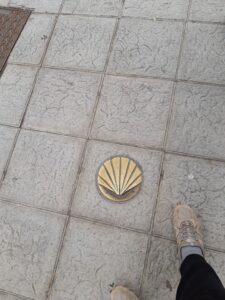I had read about the pilgrimage route to Santiago and decided that for this year, my 50th birthday, I’d like to go to Santiago de Compostela. I planned to take one of the pathways that lead from France to the north western Spain, driving mostly and then walking some of the route. However, when I’d researched that it would take about 7 weeks solid walking, driving had to be the primary method of travel!
We had just bought a caravan so accommodation was made easier. We stayed in some nice and some basic campsites along the north coast of Spain from arriving by boat in Santander and travelling to Galicia, then driving down towards Portugal. On each leg of our journey we walked some of the Camino de Santiago, the route of Saint James. There are various walking routes, from the UK, France, Portugal and throughout Spain, which all lead to Santiago. The route is marked with the scallop shell symbol which the pilgrimage route adopted for walkers to easily identify the walking paths.

We arrived on the Friday of the last week of our holidays, and walked from the campsite in Santiago to the centre and to the cathedral. The queue to enter the cathedral was long but we were lucky enough to take part in the midday mass, still very much under Covid rules (masks were mandatory).
Such a special journey and a quite possible the most moving and entertaining service I’ve ever witnessed. Following the service conducted by the bishop of Santiago mostly in Spanish and Galician, with some English, French and Italian in the mix, the church officials then got to work on the entertainment! The lantern (or I thought it was lantern hanging in the centre of the Cathedral), turned out to be a large incense burner (the Botafumeiro) that was swung on a rope between the rows of seats with onlookers (and us), dipping our heads as it seemed to just miss us, but obviously it was quite safe?! [1]

The cathedral is home to the relic of the apostle Saint James (Santiago) which lie in the crypt. The altarpiece is the central masterpiece with an impressive amount of gold, carvings, marble and more gold. As with many Catholic church’s, the decor was elaborate and here on display were many heraldic shields indicating the heritage of Galicia, and adopted by the clergy and the council.

Outside the Cathedral is the Portico de la Gloria – 12th century carved stone by the master Mateo and a number of museums. The small alleyways lead to numerous tourist shops and bars and seafood restaurants are plentiful. The pulpo (octopus) is excellent!
It has been a wonderful experience and I’d recommend the journey both to Galicia, Spain’s rugged northern coast, and the pilgrimage to Santiago, by whatever means you feel comfortable with. We passed many who had walked an official route, those who were walking literally their ‘last leg’ and those who drove most of the way and walked a few miles (myself and my husband).
I feel privileged to have seen for myself the Galician culture, heritage and gastronomy, and what many thousands of people have travelled to see over the centuries. Now on with the birthday celebrations!

#history #birthday #summerholiday #heritage #Santiago #heraldry
[1] Botafumeiro – https://en.Wikipedia.org/wiki/Botafumeiro#Accidents : accessed 05 September 2022.
Subscribe to the Blog and follow me on social media
